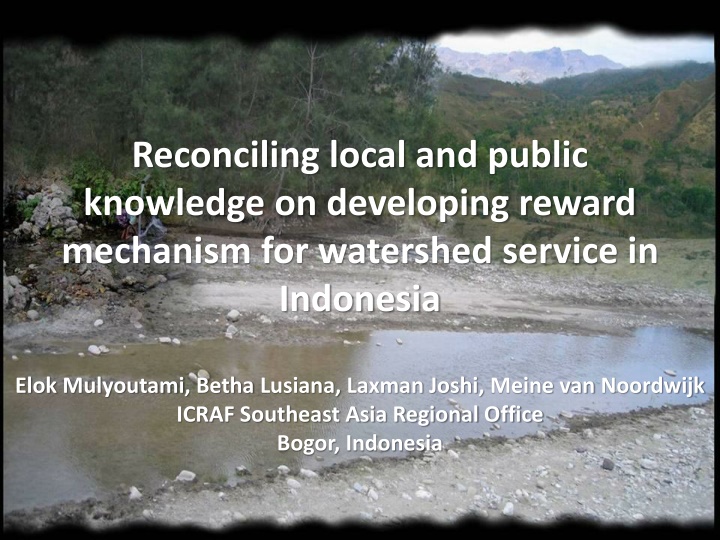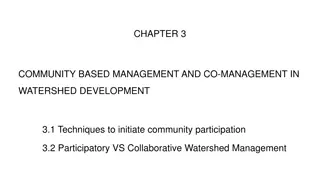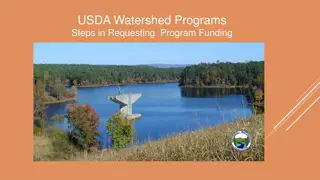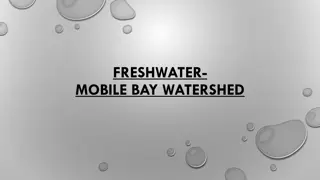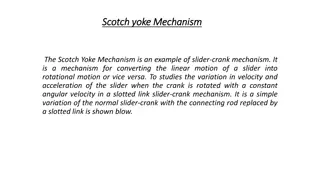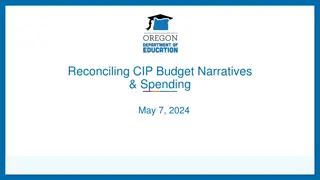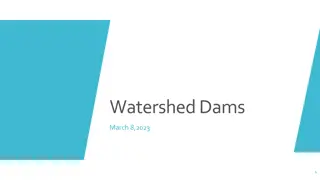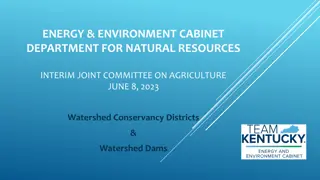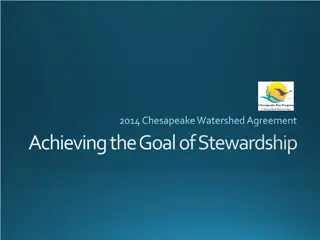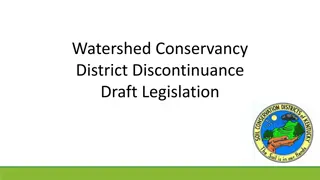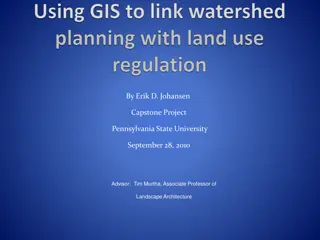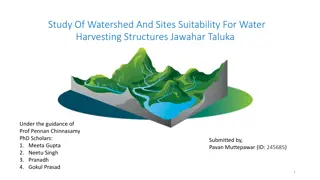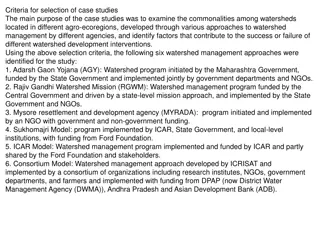Developing Reward Mechanism for Watershed Services in Indonesia: Reconciling Local and Public Knowledge
This study focuses on reconciling local and public knowledge for developing a reward mechanism for watershed services in Indonesia. It discusses multi-stakeholder knowledge systems, knowledge acquisition methodologies, case studies from three locations in Indonesia, and local insights on landscape-hydrological issues in Kalimantan. The findings aim to bridge the gap between local understanding and policy frameworks to enhance environmental conservation initiatives.
Download Presentation

Please find below an Image/Link to download the presentation.
The content on the website is provided AS IS for your information and personal use only. It may not be sold, licensed, or shared on other websites without obtaining consent from the author.If you encounter any issues during the download, it is possible that the publisher has removed the file from their server.
You are allowed to download the files provided on this website for personal or commercial use, subject to the condition that they are used lawfully. All files are the property of their respective owners.
The content on the website is provided AS IS for your information and personal use only. It may not be sold, licensed, or shared on other websites without obtaining consent from the author.
E N D
Presentation Transcript
Reconciling local and public knowledge on developing reward mechanism for watershed service in Indonesia Elok Mulyoutami, Betha Lusiana, Laxman Joshi, Meine van Noordwijk ICRAF Southeast Asia Regional Office Bogor, Indonesia
Outline Multi-stakeholders knowledge system Knowledge acquisition based on case studies Reconciling local and policy maker s knowledge in the context of payment for environmental services Conclusions
Multi stakeholder knowledge NGO s Local Upland Ecological Private Lowland Knowledge Environment Public/Policy Policy maker s (local, regional, national) Ecological Knowledge Local gov t Hydrologist Other gov t institution University Ecological Knowledge Scientist
Knowledge acquisition (methodology) Local stakeholders RRA, individual interviews, direct observations, group discussions snowball sample random stratified sample Public/policy makers individual and group discussion base on stakeholder analysis Literature review
Case study from 3 location in Indonesia Singkarak Lake, West Sumatra Kapuas Hulu Basin, West Kalimantan Lahurus spring, East Nusa Tenggara
Case 1 Kalimantan: Local knowledge on relationship of landscape and hydrological issues Upstream Mid-region Downstream Issues Riverbanks collapse Soil erosion Sedimentation Floods Riverbank collapse, Soil erosion Sedimentation upstream Nanga Hovat Nanga Bungan Causing factors Degraded riparian zones Soil structure (sandy) Reduction of forest cover Degraded riparian zones Soil structures and high rainfall Sibau Hulu midstream Land use Traditionally managed complex agroforest (Tembawang system) and dryland field Rubber systems Semi-permanent upland systems (dry and wetland) Rubber systems and Semi-permanent upland (dry and wetland), Vegetable patch Datah Diaan SIBAU Livelihood Hunter and gathering Upland rice (fallow systems), rice field Livestock breeding Trader Legend MENDALAM Tanjung Karang NTFP: eaglewood (Aquilarria sp.), swiftlet nests Enrichment Tembawang or traditional agroforestry system Reducing erosion with planting trees e.g Ulin (Eusideroxylon zwageri) Establishing riverbank terraces or baraoor terrace mechanic to prevent bank collapse Sibau Hilir Village Sub village KAPUAS Gold mining Putussibau What needs to be done Upland paddy field Mature tapped rubber Newly established clonal rubber Sayut Traditional agroforestry system (tembawang) Fishing Newly established local rubber Lunsara downstream
Case 2 Policy makers reforestation programme on Sumatra: Pine (Pinus merkusii) (since 1978) Banio, Surian, Bayua, Madang (Natural Forest) Crop Pines Perception of villagers surrounding Singkarak lake: Pines absorb a lot of water from soil because they have deep roots Pines have needles with smooth surface that allows rapid water evaporation Dry needles of pines burn easily when dry. Holding water capacity of pines root is low Grass Cutting Fire hazard. Needles leaf Deep root Big leaf Used for fire wood and hut. Land coverage Tree density Type of Soil Soil evaporation Clay Groundwater Limestone After several years policy makers or public perception Pine tree planting is a problem in terms of inducing excessive water use and fire risk. Pines do impact negatively on catchment function. Planting of broad leaf trees is better as they use less water. Dry Season Rainy Dry Water Source Rainy
Case 3 Policy makers reforestation programme on Nusa Tenggara Teak (Tectona grandis) - 1990 Perception of people surrounding Lahurus spring about Teak Teak leaves release a lot of water in air (transpiration) The amount of water absorbed by Teak is high Teak makes soil dry Teak is very competitive for water Teak should not be planted near other valuable plants Forest cover Steep slopes Root system Litter thickness Teak (Tectona grandis) Canopy closure Local beliefs about traditional agroforestry system around the spring (mamar) and trees Soil evaporation Soil moisture Soil type Protection of forests/vegetation around springs will maintain water quality and quantity Terraces Solum depth Soil infiltration Following trees are good for water in the springs: kelapa hutan (Pandanus sp.), jambu air hutan (Syzigium spp), beringin (Ficus sp), mahoni (mahogany), johar/black-wood cassia (Senna siamea), mangga hitam (Mangivera sp), kelapa (coconut), pinang /betelnut (Areca catechu) and kemiri/candlenut (Aleurites moluccana) Runoff Ground water Soil erosion Spring recharge Top soil loss Soil fertility
Difference characteristics of local and public/policy maker knowledge Local knowledge Public knowledge Knowledge holder Local community Multi stakeholder, Multi categories and levels Through some formal education, training, workshop, and sometimes informal Limited by institutional interest Covering wide (basin and landscape) area Generation process Through long periods of trial- and-error; enlightened guesses, and adaptation Site specific: plot and landscape level Influence by physical characteristics, social and cultural value Gaps on some details Explanatory Interdisciplinary and holistic Plot level and landscape level Scope Characteristics Influenced by structural and political environment (interest and power relation) Exploratory, General, covering wide issues Approach Landscape level to wider level (basin) Scientific understanding will strengthen the predictability.
C o n c l u d i n g r e m a r k s The importance of study local knowledge: wisdom, insight realistic legitimacy of action voluntary possible criteria and indicator conditionality The importanceof inclusion of public or policy maker s knowledge Previous or existing action or policy condition realistic Role of each stakeholder voluntary Risk assessment, resolution conflict Knowledge articulation can help in understanding similarities, differences and gaps in the knowledge systems of stakeholder groups lead to strategic communication Reconciling the knowledge system of each stakeholder is an important step on building strategic communication as a platform for negotiation on integrated natural resource management e.g. reward mechanisms Science understanding will strengthen the prediction, together with local and policy makers knowledge can indicate appropriate actions
